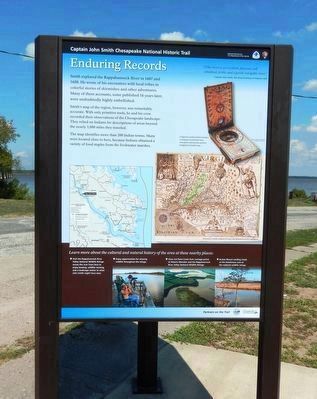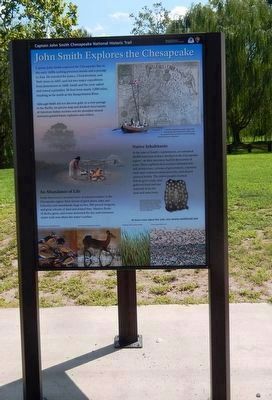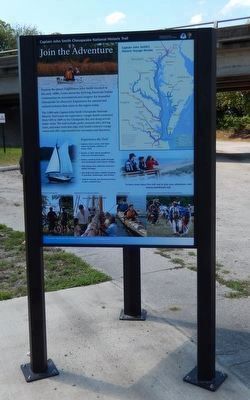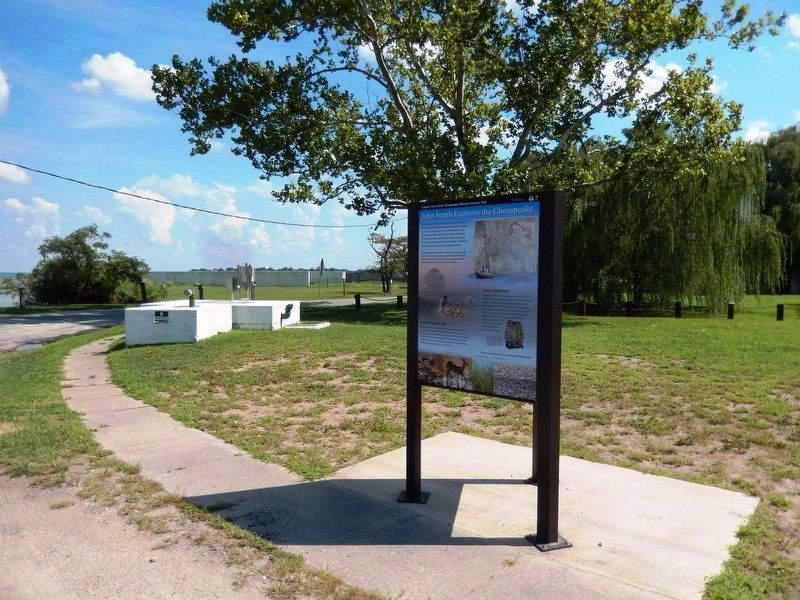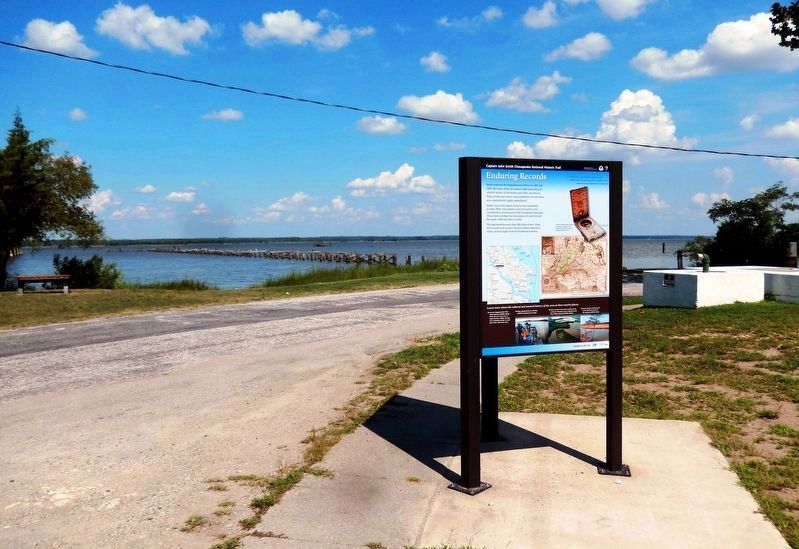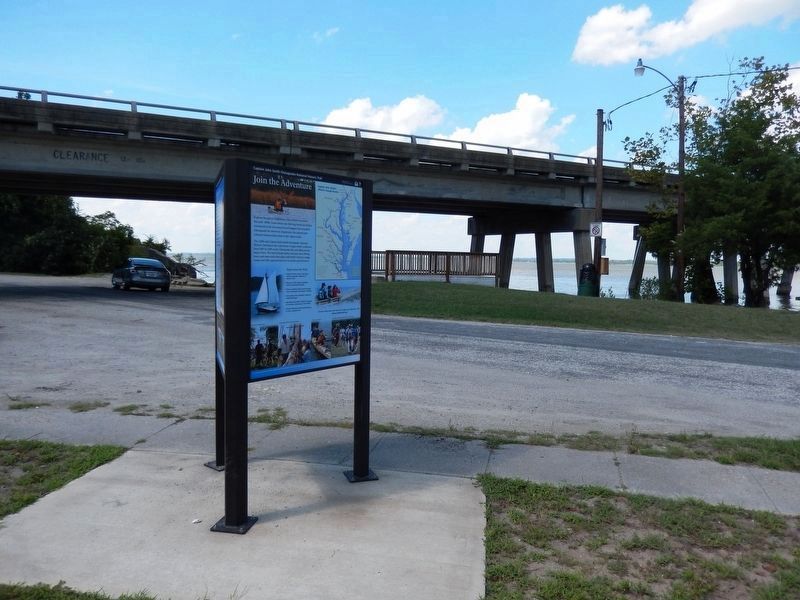Tappahannock in Essex County, Virginia — The American South (Mid-Atlantic)
Enduring Records
Captain John Smith Chesapeake National Historic Trail
(panel 1)
Enduring Records
Smith explored the Rappahannock River in 1607 and 1608. He wrote of his encounters with local tribes in colorful stories of skirmishes and other adventures. Many of these accounts, some published 16 years later, were undoubtedly highly embellished.
Smith’s map of the region, however, was remarkably accurate. With only primitive tools, he and his crew recorded their observations of the Chesapeake landscape. They relied on Indians for descriptions of areas beyond the nearly 3,000 miles they traveled.
The map identifies more than 200 Indian towns. Many were located close to here, because Indians obtained a variety of food staples from the freshwater marshes.
“(This river) is an excellent, pleasant, well inhabited, fertile, and a goodly navigable river.”
–Captain John Smith, The General History of Virginia, 1624.
(captions)
A diptych sundial (which includes a compass) would have been among the instruments used for navigation in Smith’s day.
1660 edition of Smith’s original 1612 map, with Rappahannock River highlighted.
(sidebar)
Learn more about the cultural and natural history of the area at these nearby places:
• Visit the Rappahannock River Valley National Wildlife Refuge across the river from here to enjoy boating, wildlife viewing, and a landscape similar to what John Smith might have seen.
• Enjoy opportunities for viewing wildlife throughout the refuge.
• View Cat Point Creek from vantage points at Historic Menokin and the Rappahannock River Valley National Wildlife Refuge.
• Access Mount Landing Creek at the Hutchinson unit of the national wildlife refuge.
(panel 2)
John Smith Explores the Chesapeake
Captain John Smith explored the Chesapeake Bay in the early 1600s seeking precious metals and a passage to Asia. He traveled the James, Chickahominy, and York rivers in 1607, and led two major expeditions from Jamestown in 1608. Smith and his crew sailed and rowed a primitive 30-foot boat nearly 3,000 miles, reaching as far north as the Susquehanna River.
Although Smith did not discover gold, or a river to the Pacific, his precise map and detailed observations of American Indian societies and the abundant natural resources guided future explorers and settlers.
Native Inhabitants
At the time of Smith's explorations, an estimated 50,000 American Indians dwelled in the Chesapeake region—as their ancestors had for thousands of years. Their sophisticated societies included arts and architecture, systems of government, extensive trade and communication networks, and shared spiritual beliefs. The native people hunted, fished, grew crops, and gathered food and raw materials from the land and waterways.
An Abundance of Life
Smith discovered a treasure trove of natural wonders in the Chesapeake region: thick forests of giant pines, oaks, and hickories; vast marshlands, huge turtles, 800-pound sturgeon, and great schools of shad and striped bass. Massive flocks of ducks, geese, and swans darkened the sky; and enormous oyster reefs rose above the water's surface.
To learn more about the trail visit www.smithtrail.net
(captions)
Smith’s remarkably accurate map of the Chesapeake Bay (published in 1612), and his spirited written accounts of a lush landscape inspired European migration.
Decorative shells-such as those found on this ceremonial robe-were valuable in the American Indian’s trading network that extended for hundreds of miles. This robe (which may have belonged to paramount chief Powhatan) was crafted from four elk skins and adorned with more than 17,000 shells.
Wood ducks and other waterfowl flourished
The forests and lowlands teemed with deer
Cattails grew thick in pristine marshes
Flocks of geese filled the sky
(panel 3)
Join the Adventure
Explore the places Englishman John Smith traveled in the early 1600s. Learn about the thriving American Indian communities he encountered and imagine the bountiful Chesapeake he observed. Experience the natural and cultural richness that exists in the region today.
The 3,000-mile Captain John Smith Chesapeake National Historic Trail traces the exploratory voyages Smith conducted from 1607 to 1609 on the Chesapeake Bay and along several major rivers. The trail includes parks, museum sites, driving tours, and water trails that align with Smith's historic voyage routes and offer opportunities for recreation and discovery.
Experience the Trail
• Explore rivers, coves, and open water by kayak, sailboat, or motor craft.
• Bicycle or hike along woodland trails and shoreline paths.
• Follow winding back roads through rural landscapes and historic villages.
• Visit places that celebrate American Indian heritage.
• See birds and other wildlife foraging in marshes, waterways, and forests.
• Attend festivals and demonstrations, or join a guided tour.
To learn more about the trail and to plan your adventure, visit
www.smithtrail.net
(captions)
Captain John Smith’s Historic Voyage Routes
“Here are mountains, hils, plaines, valleys, rivers, and brookes all running most pleasantly into a faire Bay compassed but for the mouth with fruitful and delightsome land.”
– John Smith, 1612
Overlooking the Susquehanna River
Students aboard Discovery at Jamestown Settlement
Kayakers explore the trail
Indian dance demonstration at Jefferson Patterson Park and Monument
Erected by National Park Service, U.S. Department of the Interiror.
Topics and series. This historical marker is listed in these topic lists: Agriculture • Colonial Era • Exploration • Native Americans • Settlements & Settlers. In addition, it is included in the Captain John Smith Chesapeake National Historic Trail series list. A significant historical year for this entry is 1607.
Location. 37° 55.825′ N, 76° 51.419′ W. Marker is in Tappahannock, Virginia, in Essex County. Marker is on Newbill Drive (County Route T-1013) north of Prince Street, on the left when traveling north. Touch for map. Marker is in this post office area: Tappahannock VA 22560, United States of America. Touch for directions.
Other nearby markers. At least 8 other markers are within walking distance of this marker. Historic Tappahannock (about 400 feet away, measured in a direct line); British Raid on Tappahannock / The War of 1812 (about 400 feet away); The Manning House (about 500 feet away); The Golden Leaf that Built a Port (about 500 feet away); Max Silver (about 500 feet away); Blake-Brockenbrough Cemetery (about 600 feet away); Ritchie's Birthplace (approx. 0.2 miles away); Veterans Memorial (approx. 0.2 miles away). Touch for a list and map of all markers in Tappahannock.
Also see . . . Captain John Smith Chesapeake National Historic Trail. National Park Service (Submitted on August 25, 2016.)
Credits. This page was last revised on August 29, 2016. It was originally submitted on August 22, 2016, by Don Morfe of Baltimore, Maryland. This page has been viewed 494 times since then and 13 times this year. Photos: 1, 2, 3, 4, 5, 6. submitted on August 22, 2016, by Don Morfe of Baltimore, Maryland. • Bernard Fisher was the editor who published this page.
